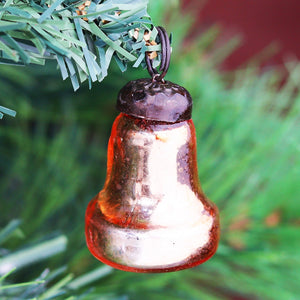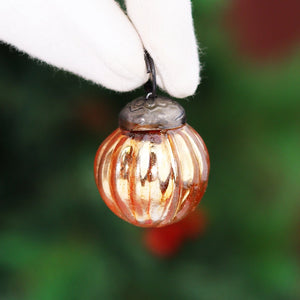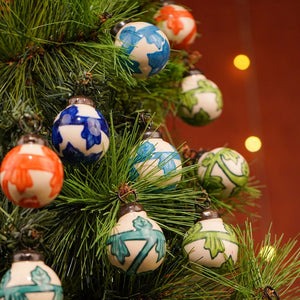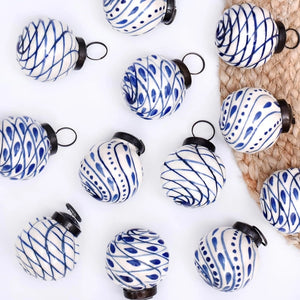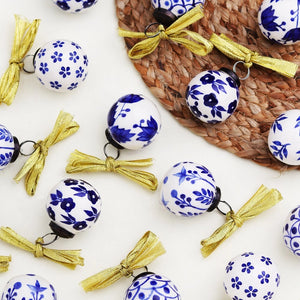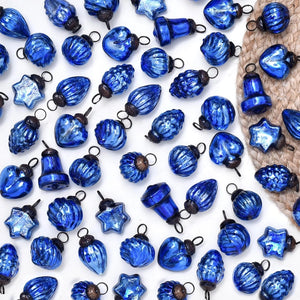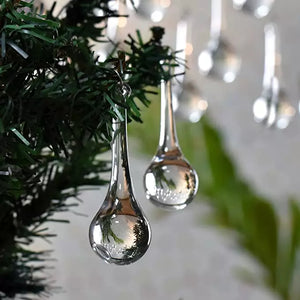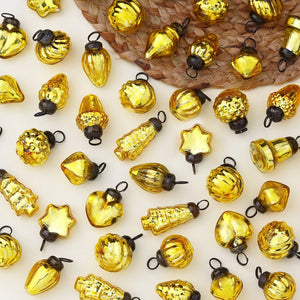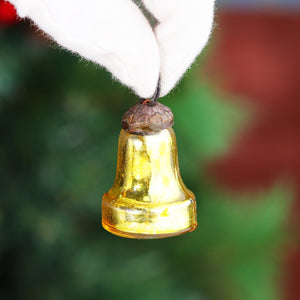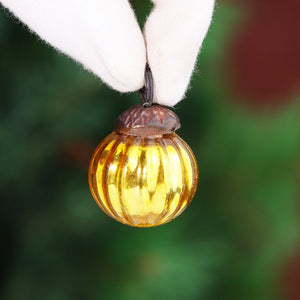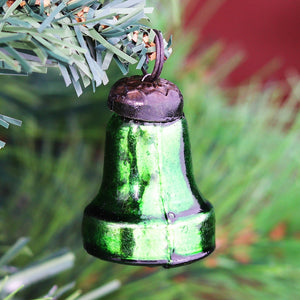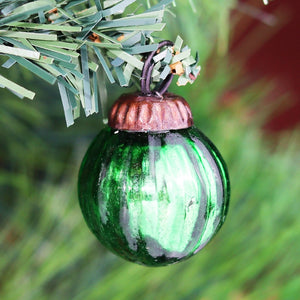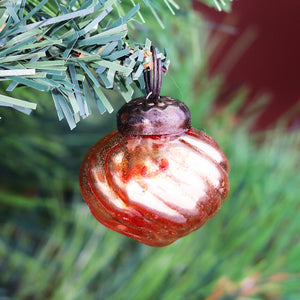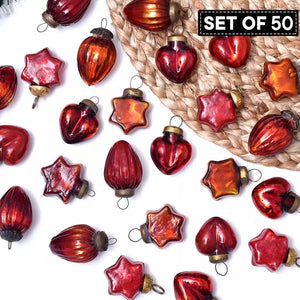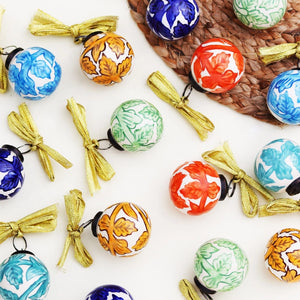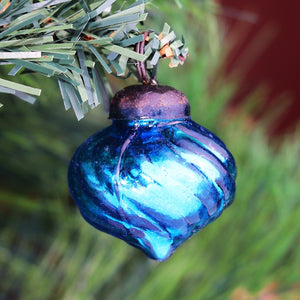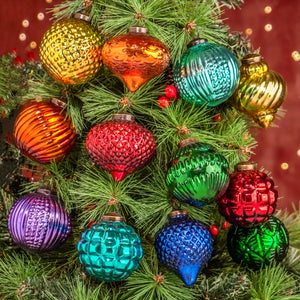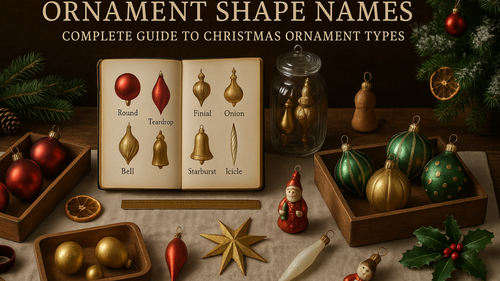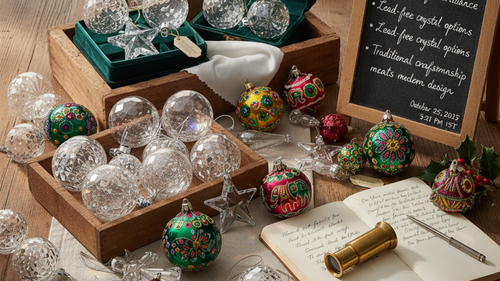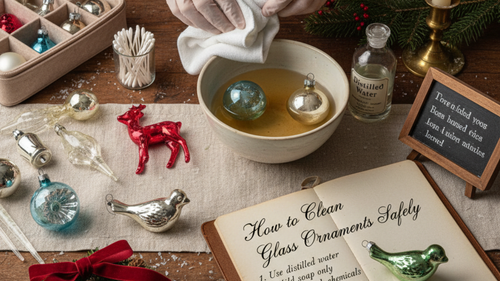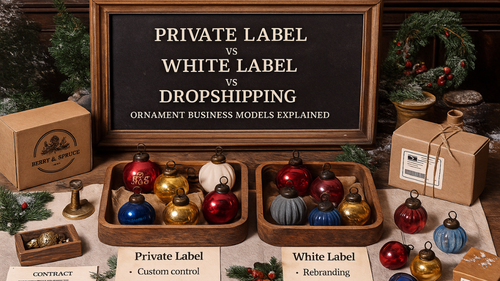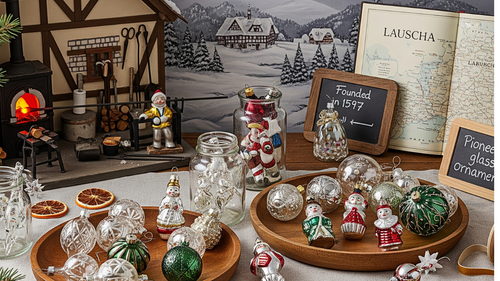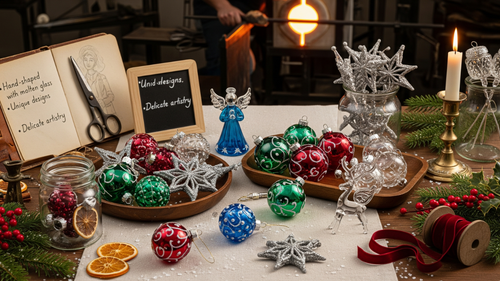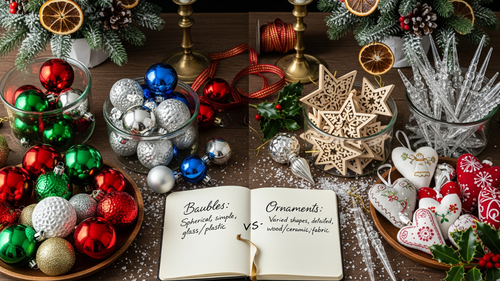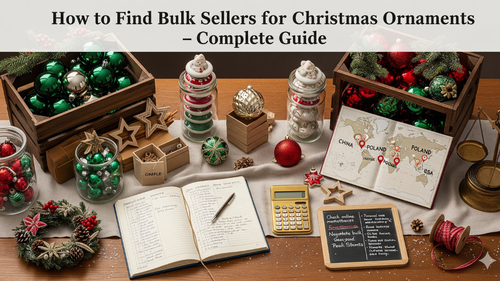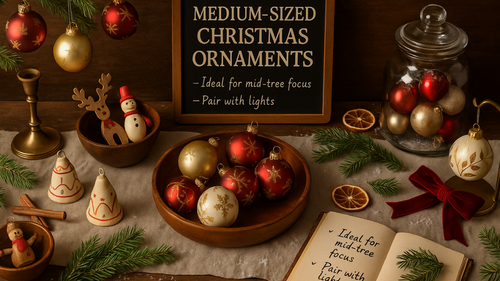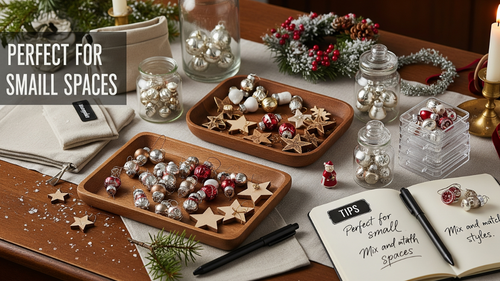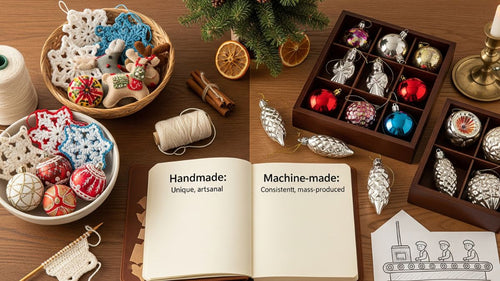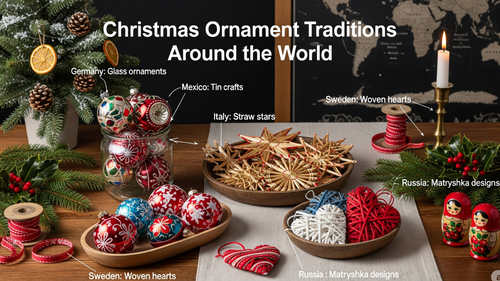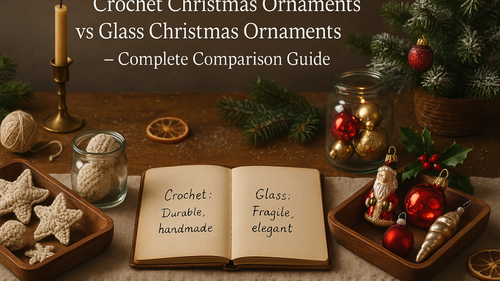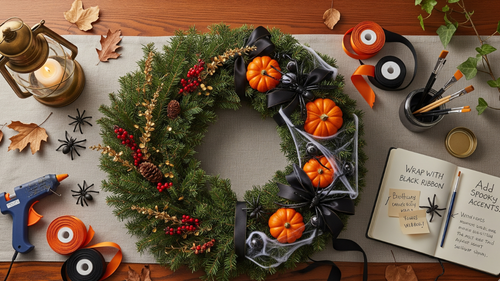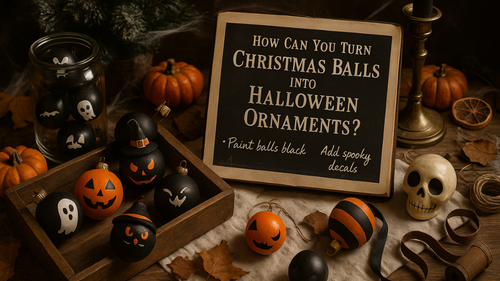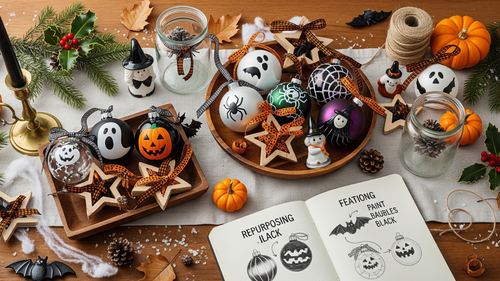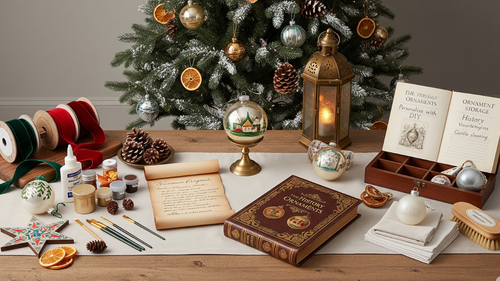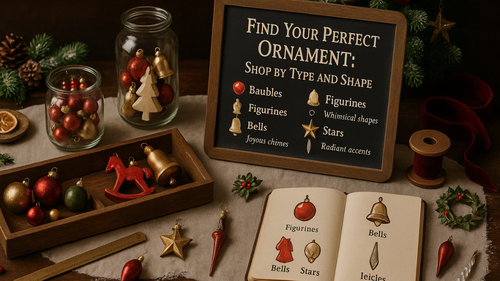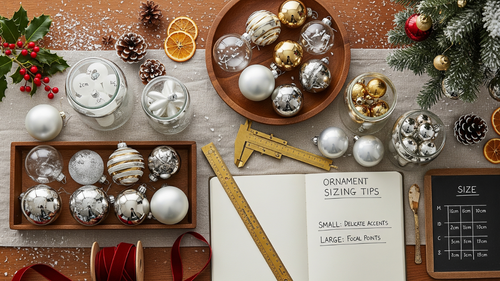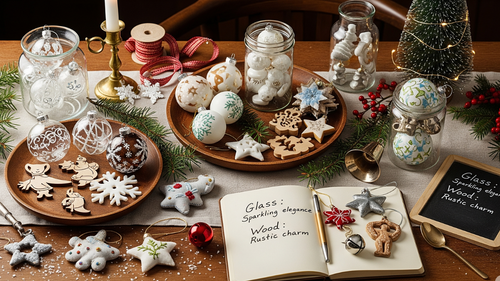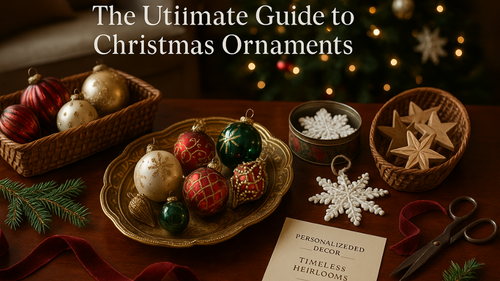Proper ornament storage extends the life of fragile decorations, saves space, prevents damage, and makes holiday decorating faster and more enjoyable. With Americans spending an average of $902 per person on holiday items in 2024, protecting these investments becomes crucial for long-term enjoyment and value preservation.
The holiday decoration market, valued at $5.33 billion in 2024 and projected to reach $8.57 billion by 2033, reflects the growing importance families place on creating memorable holiday traditions. Whether you own delicate heirloom pieces, handcrafted treasures from our DIY ornament collection, or modern collectibles, understanding proper storage techniques ensures these cherished decorations remain beautiful for generations.
Featured Products
This comprehensive guide addresses every aspect of ornament storage, from material-specific care requirements to innovative organizational systems. You'll discover professional techniques for wrapping delicate pieces, learn about optimal storage environments, and explore creative solutions for maximizing space while maintaining accessibility. By implementing these proven methods, you'll transform holiday setup from a stressful scramble into an efficient, enjoyable tradition.
Table of Contents
- Why Proper Ornament Storage Matters
- Understanding Ornament Types and Their Storage Needs
- Organizing and Storing Christmas Ornaments
- How Should I Organize Ornaments by Theme, Color, and Size?
- How Do I Choose the Right Ornament Storage Container?
- Wrapping and Packaging Techniques
- Long-Term Storage and Seasonal Care
- Storing Wooden, Fabric, and Plush Ornaments
- Storage by Climate and Region
- Special Care for Collectibles and Heirlooms
- What Are the Best DIY Ornament Storage Solutions?
- Oversized and Specialty Ornament Storage
- Maintaining and Updating Your Storage System
- Off-Season and Transitional Ornament Uses
- FAQs – Christmas Ornament Storage
Key Takeaways
- Material-Specific Care: Each ornament type requires unique storage conditions – glass needs padding, metal requires moisture control, and fabric demands breathable containers
- Investment Protection: Proper storage prevents costly replacements and preserves sentimental value of heirloom pieces
- Organization Systems: Labeling and categorizing ornaments reduces setup time and prevents handling damage during retrieval
- Environmental Factors: Temperature stability, humidity control, and pest prevention are essential for long-term preservation
- Cost-Effective Solutions: DIY storage options using household items can be as effective as commercial products when implemented correctly
Why Proper Ornament Storage Matters
Protecting your ornament collection goes far beyond simple organization. Quality Christmas ornaments represent significant financial investments, with 42% of consumers spending over $150 on holiday decorations annually. Whether you're preserving delicate glass ornaments or durable metal decorations, these pieces carry irreplaceable emotional value, connecting families to cherished memories and traditions passed down through generations.
Improper storage leads to predictable damage patterns that destroy both monetary and sentimental value. Glass ornaments develop hairline cracks from temperature fluctuations, metal pieces tarnish from humidity exposure, and delicate painted details fade under harsh lighting. These problems compound over time, turning beautiful keepsakes into disappointments that diminish holiday joy.
Featured Products
Common storage mistakes include stacking ornaments without protection, storing in temperature-variable locations like attics or basements, using plastic bags that trap moisture, and failing to clean pieces before storage. Each error accelerates deterioration, making proper technique essential for preservation.
Professional storage methods prevent breakage, preserve original colors, maintain structural integrity, and protect against environmental damage. These practices also improve accessibility, reducing handling time and minimizing accidental damage during setup. The initial investment in proper storage pays dividends through extended ornament life, reduced replacement costs, and enhanced holiday experiences.
Understanding Ornament Types and Their Storage Needs
Different materials require specific storage approaches to maintain their integrity and appearance. Understanding these requirements forms the foundation of effective ornament preservation.
Featured Products
Glass and Crystal Ornaments: These delicate pieces represent the largest category of fragile decorations. Glass responds poorly to temperature changes, developing stress fractures that lead to complete breaks. Crystal ornaments require even more careful handling due to their complex internal structures. When shopping by material, prioritize individual wrapping with acid-free tissue paper, cushioned dividers, and stable temperatures. Avoid direct contact between pieces and never stack glass ornaments directly on top of each other.
Metal Ornaments: Metal decorations face unique challenges from oxidation, scratching, and chemical reactions. Brass and copper develop patina when exposed to moisture, while silver pieces tarnish from sulfur compounds in the air. Iron-based metals rust when humidity levels exceed 50%. These ornaments benefit from silica gel packets, anti-tarnish strips, and breathable fabric wrapping that prevents direct metal-to-metal contact.
Ceramic and Porcelain: These fired clay materials resist moisture but remain vulnerable to impact damage and thermal shock. Glazed surfaces can crack when exposed to rapid temperature changes, while unglazed pieces absorb odors and moisture from surrounding environments. Store ceramic ornaments in stable temperature locations with adequate cushioning between pieces.
Featured Products
Fabric and Paper Ornaments: Natural materials like fabric, paper, and wood require the most careful environmental control. These pieces absorb moisture readily, leading to mold, mildew, and structural degradation. Paper ornaments fade quickly under light exposure, while fabric pieces attract dust and insects. Store these materials in breathable containers with consistent humidity levels below 60%.
Wooden Ornaments: Wood presents unique storage challenges due to its organic nature and susceptibility to environmental changes. Wooden pieces expand and contract with humidity fluctuations, causing splits, cracks, and joint separation. They're particularly vulnerable to mold growth in humid conditions and insect damage from wood-boring beetles. Store wooden ornaments in stable environments with 30-50% humidity, using cedar blocks for natural pest deterrence while avoiding direct cedar contact that can stain lighter woods.
Plush and Fabric Ornaments: Soft ornaments require specialized care to prevent dust accumulation, pest infestation, and fabric deterioration. Plush materials attract dust mites, while natural fibers appeal to clothing moths and carpet beetles. These ornaments benefit from regular vacuuming with soft brush attachments, lavender sachets for natural pest deterrence, and breathable cotton storage bags that allow air circulation while preventing dust buildup.
Oversized Ornaments: Large decorative pieces present unique storage challenges due to their size and weight. These items often require custom storage solutions, dedicated spaces, and special handling procedures. Consider disassembly options for multi-part ornaments and invest in wheeled storage containers for easier transport.
Organizing and Storing Christmas Ornaments
Effective organization transforms chaotic holiday setup into streamlined traditions. Strategic categorization reduces handling time, minimizes damage risk, and ensures quick access to specific pieces when decorating.
Begin by cataloging your entire collection, noting each piece's material, size, fragility level, and sentimental value. This inventory becomes the foundation for your organizational system, guiding storage decisions and replacement planning. Document unique pieces with photographs, including close-ups of distinctive features or damage. For comprehensive organization tips, reference our guide on finding ornaments by type and shape.
Group ornaments by compatibility rather than appearance alone. Combine pieces with similar storage requirements – all glass ornaments together, all metal pieces in another section, and fabric items in breathable containers. This approach prevents cross-contamination and allows for material-specific storage conditions.
Size-based organization maximizes space efficiency while protecting delicate pieces. Store small ornaments in compartmentalized containers, medium pieces in padded boxes, and large items in dedicated spaces. This prevents larger pieces from crushing smaller ones and reduces the number of containers needed.
Theme-based storage appeals to families who decorate specific rooms or trees with coordinated ornaments. Create separate collections for children's ornaments, religious pieces, nature themes, or color-coordinated schemes. This system speeds decorating while maintaining coherent design aesthetics. Consider seasonal themes beyond Christmas, such as Halloween decoration adaptations that extend ornament utility year-round.
Priority-based organization ensures easy access to most-used pieces. Store frequently displayed ornaments in easily accessible containers, while rarely used pieces can occupy harder-to-reach storage areas. This approach reduces handling of the entire collection during partial decorating sessions.
How Should I Organize Ornaments by Theme, Color, and Size?
Systematic organization by theme, color, and size transforms chaotic storage into efficient systems that support specific decorating styles and family traditions. This approach reduces setup time while ensuring coherent visual presentations across different spaces and occasions.
Theme-Based Organization: Create dedicated collections for distinct decorating themes that reflect your family's traditions and preferences. Religious ornament collections maintain spiritual significance while simplifying church or faith-based decorating. Children's ornament sections preserve handmade treasures and age-appropriate pieces for kid-friendly trees. Nature-themed collections support rustic or outdoor-inspired displays, while vintage collections maintain historical coherence.
Seasonal theme expansion extends ornament utility beyond Christmas. Halloween adaptations transform red and gold ornaments into autumn displays, while patriotic themes work for Independence Day celebrations. This cross-seasonal approach maximizes storage investment while creating year-round decorating opportunities.
Color-Coordinated Systems: Color-based organization supports sophisticated decorating schemes and simplifies designer-quality presentations. Monochromatic collections in gold, silver, or copper create elegant formal displays, while rainbow collections provide flexibility for children's spaces or eclectic themes.
Color temperature groupings organize warm colors (reds, oranges, yellows) separately from cool colors (blues, greens, purples), enabling mood-based decorating decisions. Neutral collections in whites, creams, and naturals provide timeless backdrops that complement any home décor style.
Size-Strategic Storage: Size-based organization prevents damage while maximizing space efficiency. Miniature ornaments require different handling than statement pieces, with storage solutions scaled appropriately for each category.
Create graduated size systems where small ornaments fill gaps between larger pieces, medium ornaments provide visual transition, and oversized pieces serve as focal points. This approach mirrors professional tree decorating techniques while ensuring every piece has appropriate storage protection.
Practical Checklist for Ornament Organization
- Step 1: Group ornaments by theme, color scheme, or material type.
- Step 2: Place each group into a dedicated container with dividers.
- Step 3: Label containers clearly using permanent tags or printed labels.
- Step 4: Store priority or frequently used ornaments in easily accessible boxes.
- Step 5: Keep fragile or heirloom ornaments in separate, padded storage to prevent accidental mixing.
How Do I Choose the Right Ornament Storage Container?
Container selection directly impacts ornament preservation success. The right storage solution balances protection, accessibility, space efficiency, and long-term durability while accommodating your specific collection needs.
Plastic storage bins offer excellent protection from moisture, pests, and temperature fluctuations. Choose containers with secure, airtight seals and sturdy construction that withstands stacking. Clear sides allow content identification without opening, reducing handling damage. Avoid containers with thin walls that crack under weight or temperature stress.
Archival-quality boxes provide superior protection for valuable or sentimental pieces. These acid-free, lignin-free containers prevent chemical deterioration while allowing proper air circulation. Though more expensive than plastic alternatives, archival boxes offer museum-quality preservation for irreplaceable ornaments.
Fabric storage chests combine protection with attractive appearance. Cedar-lined chests naturally repel insects while adding pleasant fragrance. Canvas and fabric containers allow air circulation, preventing moisture buildup that damages natural materials. However, these options provide less protection from impacts and moisture than hard-sided alternatives.
Specialized ornament storage boxes feature built-in dividers, cushioned compartments, and secure closures designed specifically for holiday decorations. While convenient, these purpose-built solutions often cost more than generic alternatives and may not accommodate unusual ornament shapes or sizes.
DIY container adaptations transform household items into effective storage solutions. Wine boxes with cardboard dividers, egg cartons for small ornaments, and shoe boxes with custom padding offer cost-effective alternatives. Success depends on proper material selection and construction techniques that match commercial product quality.
Consider container stackability, weight capacity, and access frequency when making selections. Frequently accessed containers should prioritize ease of opening and carrying, while long-term storage containers can emphasize maximum protection over convenience.
Wrapping and Packaging Techniques
Individual ornament wrapping provides the first line of defense against damage. Professional techniques adapted from museum conservation ensure maximum protection while maintaining practical accessibility.
Acid-free tissue paper represents the gold standard for ornament wrapping. This archival material prevents chemical reactions that cause discoloration, brittleness, and deterioration. Wrap each ornament individually, creating multiple layers that cushion against impacts while allowing air circulation. Secure wrapping with archival tape that removes cleanly without leaving residue.
Bubble wrap offers superior impact protection for especially fragile pieces. Use small-bubble varieties for detailed ornaments and large-bubble options for simple shapes. Always place tissue paper between bubble wrap and ornament surfaces to prevent plastic chemicals from contacting decorative finishes. Bubble wrap's static properties can attract dust, making removal and rewrapping necessary for long-term storage.
Microfiber cloths provide excellent protection for metal ornaments while preventing tarnishing. These synthetic materials don't contain sulfur compounds that accelerate metal oxidation. Wrap metal pieces snugly to prevent movement while allowing air circulation. Microfiber cloths can be reused multiple times, making them cost-effective for large collections.
Avoid plastic bags, newspaper, or regular tissue paper for long-term storage. Plastic bags trap moisture and create condensation cycles that promote corrosion and mold growth. Newspaper contains acids that transfer to ornament surfaces, causing staining and deterioration. Regular tissue paper lacks acid-neutralization and may contain bleaching agents that damage finishes.
Color-coding wrapped ornaments accelerates unpacking and organization. Use different wrapping materials or colored ribbons to identify categories – red tissue for glass, blue for metal, green for fabric. This system allows quick identification without unwrapping, reducing handling damage during selection.
Layer wrapping provides maximum protection for irreplaceable pieces. Begin with acid-free tissue paper against the ornament surface, add bubble wrap for impact protection, then enclose in archival paper for environmental protection. While time-intensive, this technique offers museum-quality preservation for heirloom pieces.
Long-Term Storage and Seasonal Care
Environmental conditions determine ornament longevity more than any other factor. Creating stable storage environments requires understanding temperature, humidity, light, and air quality impacts on different materials.
Temperature stability prevents the expansion and contraction cycles that crack glass, loosen adhesives, and stress joints in composite ornaments. Maintain storage temperatures between 60-75°F with minimal daily fluctuation. Avoid attics, basements, and garages where temperature swings exceed 20-degree ranges. Climate-controlled indoor closets provide ideal conditions for most ornament collections.
Humidity control prevents mold, mildew, corrosion, and structural damage. Target relative humidity between 30-50% for mixed collections, using dehumidifiers in damp climates and humidifiers in arid regions. Silica gel packets provide localized humidity control within storage containers, absorbing excess moisture during humid periods and releasing it during dry spells.
Light protection prevents fading, chemical breakdown, and temperature increases within storage containers. Store ornaments in dark locations or opaque containers, avoiding areas with direct sunlight, fluorescent lighting, or heat-generating fixtures. UV-filtering window films provide additional protection in unavoidable light exposure situations.
Air quality management prevents chemical damage and pest infestations. Avoid storage near cleaning supplies, paints, or other chemical sources that release vapors. Ensure adequate ventilation to prevent stagnant air conditions that encourage mold growth. Cedar blocks, activated charcoal, or commercial moisture absorbers help maintain clean storage environments.
Seasonal maintenance inspections identify problems before they cause irreversible damage. Check storage areas quarterly for pest signs, moisture problems, or temperature variations. Inspect high-value ornaments annually, documenting changes and addressing issues promptly. Replace degraded wrapping materials and update storage conditions as collections grow or environmental factors change.
Preparation rituals before storage ensure optimal preservation. Clean ornaments gently with appropriate materials – soft brushes for textured surfaces, microfiber cloths for smooth finishes, and specialized cleaners for specific materials. Allow pieces to dry completely before wrapping, preventing trapped moisture that promotes deterioration. Document the condition of valuable pieces with photographs for insurance and inheritance purposes.
Storing Wooden, Fabric, and Plush Ornaments
Natural and soft materials require specialized storage approaches that address their unique vulnerabilities while maintaining their beauty and structural integrity. These ornament categories often hold significant sentimental value, making proper preservation especially important for family traditions.
Wooden Ornament Preservation: Wood responds dramatically to environmental changes, making climate control essential for long-term preservation. Maintain consistent humidity between 30-50% to prevent expansion and contraction cycles that cause splitting and joint failure. Temperature stability prevents resin bleeding in softwoods and finish cracking in painted pieces.
Natural wood treatments enhance preservation without compromising appearance. Food-grade mineral oil applications every few years maintain wood flexibility and prevent drying cracks. Avoid petroleum-based products that can darken wood or interfere with paint adhesion. Cedar storage environments provide natural pest protection while imparting pleasant fragrance.
Inspect wooden ornaments annually for insect damage, particularly exit holes from wood-boring beetles or powder post beetles. Early detection prevents colony establishment that can destroy entire collections. Professional pest treatment may be necessary for valuable carved pieces or extensive infestations.
Fabric Ornament Care: Textile ornaments require gentle handling and protection from multiple deterioration factors including light exposure, dust accumulation, and pest attraction. Natural fibers like cotton, wool, and silk are particularly vulnerable to insect damage from clothing moths and carpet beetles.
Pre-storage cleaning removes oils, dust, and food residues that attract pests. Use soft brushes or low-suction vacuuming with mesh screens to protect delicate fabrics. Avoid water-based cleaning that can cause shrinkage, color bleeding, or structural damage to composite ornaments.
Acid-free tissue paper provides excellent wrapping for delicate fabrics while preventing contact with potentially harmful storage materials. Lavender sachets, cedar blocks, or museum-grade pest deterrents provide natural protection without chemical residues that might damage sensitive materials.
Plush and Stuffed Ornament Storage: Soft ornaments accumulate dust and allergens while providing attractive nesting materials for insects and small pests. Regular maintenance prevents these problems while preserving the tactile qualities that make these pieces special.
Gentle vacuuming with upholstery attachments removes surface dust without damaging delicate seams or attachments. Freezing treatment eliminates dust mites and small insects – seal ornaments in plastic bags and freeze for 48 hours before storage. This technique works particularly well for children's plush ornaments that receive frequent handling.
Breathable storage containers prevent moisture accumulation that leads to mold and mildew growth. Cotton muslin bags, acid-free boxes with ventilation holes, or cedar-lined chests provide excellent environments for long-term fabric and plush ornament storage.
Storage by Climate and Region
Regional climate variations demand adapted storage strategies that address specific environmental challenges while maintaining optimal ornament preservation conditions. Understanding your local climate patterns enables proactive protection against weather-related damage.
Humid Southern Climates: High humidity regions face constant challenges from moisture-related damage including mold, mildew, corrosion, and structural degradation. Maintain storage humidity below 50% using dehumidifiers, silica gel packets, or moisture-absorbing systems.
Ventilation becomes critical in humid climates to prevent stagnant air conditions that encourage mold growth. Use fans, air circulation systems, or periodic container opening to maintain air movement around stored ornaments. Avoid sealed plastic containers in humid climates unless equipped with desiccant systems.
Monitor for rust formation on metal ornaments, paying special attention to hanging hardware and wire components. Apply thin coats of clear protective wax to vulnerable metal surfaces, and inspect collections quarterly for early corrosion signs.
Cold Northern Climates: Extreme temperature variations and heating system effects create unique storage challenges in cold climates. Avoid storage locations near heating ducts, radiators, or other heat sources that create dramatic temperature fluctuations.
Condensation prevention becomes crucial when moving ornaments from cold storage areas to warm indoor spaces. Allow gradual temperature acclimation by bringing containers to intermediate temperature areas before final unpacking. This prevents condensation formation that can damage electronics, metals, and organic materials.
Static electricity increases in dry, heated indoor environments, attracting dust and creating handling hazards for delicate ornaments. Use anti-static sprays on storage containers, maintain adequate humidity levels, and handle ornaments with slightly damp hands to reduce static buildup.
Arid Western Climates: Low humidity environments cause different challenges including desiccation of natural materials, increased brittleness, and accelerated aging of organic components. Maintain minimum humidity levels around 30% to prevent excessive drying.
Dust control becomes especially important in dry climates where fine particles infiltrate storage containers and accumulate on ornament surfaces. Use sealed containers with filtration systems, and clean storage areas regularly to minimize dust exposure.
UV protection intensifies in high-altitude or desert regions where solar radiation degrades materials rapidly. Store ornaments in completely dark environments, and use UV-filtering materials for any display storage that receives indirect light exposure.
Coastal Climate Considerations: Salt air accelerates corrosion of metal components while creating unique preservation challenges for mixed-material ornaments. Wash metal ornaments annually with distilled water to remove salt deposits, and dry thoroughly before storage.
Moisture fluctuations from ocean proximity require constant monitoring and adjustment of storage conditions. Invest in continuous humidity monitoring systems, and adjust desiccant or humidification systems based on seasonal weather patterns.
Special Care for Collectibles and Heirlooms
Valuable collectibles and family heirlooms require museum-quality preservation techniques that ensure their survival for future generations while maintaining their monetary and sentimental value. These pieces often represent irreplaceable cultural artifacts that deserve professional-level care.
Insurance and Documentation: Valuable ornament collections require comprehensive documentation for insurance and estate planning purposes. Professional appraisals establish current market values while detailed photography captures condition and provenance information.
Create detailed inventory databases that include purchase information, condition assessments, and historical significance for each valuable piece. Store documentation separately from collections in fireproof locations or cloud-based systems that survive disasters. Update valuations every 3-5 years to maintain accurate insurance coverage.
Consider specialized collectibles insurance that covers ornaments at replacement value rather than depreciated worth. Standard homeowner's policies often provide inadequate coverage for valuable holiday collections, making dedicated coverage essential for serious collectors.
Archival Storage Materials: Museum-quality materials justify their cost for irreplaceable pieces through superior preservation performance and chemical stability. Acid-free, lignin-free storage boxes prevent chemical deterioration while allowing proper air circulation.
Archival tissue paper, Tyvek envelopes, and museum-grade protective enclosures provide the highest level of protection available for ornament storage. These materials resist aging, chemical breakdown, and environmental contamination while maintaining pH neutrality that prevents acidic damage.
Provenance preservation maintains the historical value of inherited or historically significant ornaments. Create acid-free document envelopes that accompany each piece, containing photographs, purchase receipts, family stories, and historical research. This documentation often increases value while preserving cultural significance.
Professional Conservation Services: Valuable ornaments showing signs of deterioration benefit from professional conservation treatment that stabilizes damage while preserving original materials and appearance. Museum conservators provide specialized services including structural repair, surface cleaning, and protective treatments.
Preventive conservation strategies identify potential problems before they cause irreversible damage. Professional condition assessments, environmental monitoring, and preservation planning ensure collections remain stable over decades of storage and display cycles.
Display vs. Storage Trade-offs: Shadow boxes and display cases allow year-round enjoyment of special pieces while providing excellent protection from handling damage and environmental fluctuations. UV-filtering glass, stable interior environments, and secure mounting systems create optimal display conditions.
Rotation schedules balance display enjoyment with preservation needs by limiting light exposure and environmental stress. Display pieces for 6-month periods, then return to dark storage while rotating other pieces into display positions. This approach maintains collection accessibility while minimizing cumulative damage.
What Are the Best DIY Ornament Storage Solutions?
Creative repurposing transforms common household items into effective ornament storage solutions. These DIY approaches offer significant cost savings while providing customization options that commercial products cannot match.
Egg cartons excel at storing small, round ornaments individually. Cardboard cartons work best for glass and ceramic pieces, providing natural cushioning and compartmentalization. Plastic foam cartons resist moisture and pests but require additional padding for delicate finishes. Stack multiple cartons in larger containers for efficient space utilization.
Wine boxes with cardboard dividers create perfect storage for medium-sized ornaments. The sturdy construction handles stacking weight while providing natural compartments. Add tissue paper or bubble wrap around each piece for enhanced protection. Wine box dimensions accommodate most standard ornament sizes efficiently.
Shoe boxes adapt easily for flat ornaments, delicate pieces, or themed collections. Line boxes with acid-free tissue paper or fabric to create gentle storage environments. Create custom dividers using cardboard strips for compartmentalized storage. Label clearly for easy identification during holiday setup.
Coffee cans and plastic containers provide moisture-resistant storage for durable ornaments. Add padding materials like cotton batting, tissue paper, or bubble wrap to prevent movement damage. These containers work especially well for children's unbreakable ornaments or outdoor decorations that require weatherproof storage.
Apple boxes from grocery stores offer large-capacity storage for oversized ornaments or extensive collections. The sturdy construction supports heavy loads while providing ample space for bulky items. Add custom dividers and padding to prevent ornament interaction during storage and transport.
Tackle box adaptations create portable storage for small ornament collections or repair supplies. Multiple compartments allow detailed organization while sturdy construction provides excellent protection. Clear lids enable content identification without opening, reducing handling damage during selection.
Success with DIY storage depends on proper material selection and construction techniques. Use acid-free materials whenever possible, ensure adequate cushioning, and provide secure closures that prevent accidental opening. Test storage solutions with less valuable pieces before committing irreplaceable ornaments to DIY systems.
Advanced DIY Storage Solutions: Creative repurposing extends beyond basic containers to include specialized storage systems that rival commercial products in effectiveness while offering significant cost savings.
PVC pipe storage systems create custom-length protective cases for oversized baubles and delicate figurines. Cut 4-6 inch diameter pipes to desired lengths, add foam padding inside, and create removable end caps. This system provides excellent protection while allowing visual identification through clear end caps.
Hanging storage solutions maximize vertical space while minimizing handling damage. Garment bags with clear windows create protective environments for delicate ornaments while allowing easy identification. Add padded hangers or suspension systems to prevent ornament contact during storage.
Holiday gift wrap tube adaptations provide excellent protection for long, delicate ornaments like icicles or fragile figurines. Cut tubes to appropriate lengths, line with tissue paper or bubble wrap, and label clearly. These protective cases stack efficiently while providing rigid protection against crushing.
Pegboard organization systems create customizable storage walls that adapt to changing collection needs. Use hooks, containers, and shelving attachments to create efficient storage that displays collections while protecting against damage. This approach works especially well in dedicated storage rooms or large closet spaces.
Oversized and Specialty Ornament Storage
Large ornaments and unique decorative pieces require specialized storage approaches that address their specific size, weight, and handling challenges. These pieces often represent significant investments and focal points of holiday displays, making proper storage especially important.
Structural support becomes critical for oversized ornaments that may collapse under their own weight. Use rigid containers with reinforced bottoms, distribute weight across multiple support points, and avoid stacking heavy items on top of delicate pieces. Consider disassembly options for multi-part ornaments that reduce storage space requirements while simplifying handling.
Transportation considerations affect storage decisions for large pieces that require seasonal movement. Wheeled containers, handle systems, and multi-person lifting procedures prevent damage during transport. Plan storage locations that minimize handling distance and obstacles like stairs or narrow doorways.
Custom storage solutions often prove necessary for uniquely shaped or extremely large ornaments. Build storage frames, create protective enclosures, or adapt existing furniture for ornament storage. Document successful custom solutions with photographs and measurements for future reference or reproduction.
Modular storage systems accommodate growing collections of large ornaments while maintaining organization. Use expandable shelving, stackable containers, or adjustable hanging systems that adapt to changing storage needs. This flexibility prevents repeated storage system overhauls as collections evolve.
Climate control requirements intensify for large ornaments due to their increased surface area and material volume. Ensure adequate air circulation around oversized pieces while maintaining stable temperature and humidity conditions. Large ornaments may require longer acclimation periods when moving between different environmental conditions.
Off-season display options allow enjoyment of beautiful large ornaments throughout the year while providing excellent storage conditions. Decorative placement in living areas, seasonal rotation schedules, and protected outdoor displays extend ornament appreciation beyond traditional holiday periods. Learn creative ways to transform Christmas ornaments for different seasonal celebrations.
Maintaining and Updating Your Storage System
Storage systems require regular maintenance and periodic updates to remain effective as collections grow and storage needs evolve. Proactive management prevents small problems from becoming major preservation disasters.
Annual system evaluations assess storage effectiveness, identify improvement opportunities, and plan for collection growth. Document what works well, note problem areas, and research solutions for identified issues. This systematic approach ensures continuous improvement rather than reactive crisis management.
Container condition monitoring prevents storage failures that damage entire ornament groups. Check for cracks, lid problems, pest damage, or environmental issues that compromise protection. Replace degraded containers before they fail, transferring contents carefully to maintain organization systems.
Inventory management tracks collection changes, identifies missing pieces, and guides replacement decisions. Update documentation after each season, noting new acquisitions, damaged pieces, or items removed from display rotation. This information proves valuable for insurance claims and estate planning.
Technology integration can enhance storage system effectiveness through digital inventory systems, photo documentation, and reminder systems. QR codes on containers link to digital inventory lists, smartphone apps track ornament locations, and calendar reminders prompt seasonal maintenance tasks.
Space optimization becomes increasingly important as collections grow beyond initial storage capacity. Evaluate vertical storage opportunities, consider off-site storage for rarely used pieces, and explore creative space solutions like under-stair storage or converted closet systems.
Family involvement ensures storage system sustainability across generations and seasonal usage patterns. Train family members in proper handling, storage, and retrieval procedures. Delegate age-appropriate storage tasks to children, building lifelong preservation habits while sharing storage workload.
Off-Season and Transitional Ornament Uses
Creative repurposing extends ornament value throughout the year while providing alternative storage solutions that maintain pieces in excellent condition. These transitional uses maximize investment value while creating unique decorating opportunities for various celebrations and seasons.
Seasonal Adaptation Strategies: Many Christmas ornaments adapt beautifully to other holiday and seasonal celebrations with minimal modification. Red and gold ornaments transition perfectly to autumn displays, while silver and white pieces enhance winter décor beyond the holiday season.
Halloween transformation techniques convert traditional Christmas ornaments into spooky decorations using non-permanent methods like removable paint, temporary decals, or themed ribbon additions. This approach preserves original ornaments while extending their utility.
Patriotic celebrations benefit from red, white, and blue ornament collections that serve dual purposes for Independence Day, Memorial Day, and Veterans Day observances. Star-shaped ornaments, flag motifs, and metallic finishes create stunning patriotic displays that justify year-round storage investment.
Party and Event Decorating: Wedding celebrations, anniversary parties, and milestone birthdays benefit from elegant ornament displays that create sophisticated atmospheres. Glass ornaments in coordinating colors provide cost-effective alternatives to expensive floral arrangements while offering reusable value.
Corporate events and seasonal business displays utilize ornament collections for professional decorating that impresses clients while controlling costs. Neutral color schemes in gold, silver, or white complement business environments while maintaining festive appeal.
Educational and Cultural Displays: Ornament collections provide excellent educational opportunities for teaching children about cultural traditions, religious observances, and family heritage. Create rotating displays that highlight different aspects of holiday traditions throughout the year.
Historical education benefits from vintage ornament collections that illustrate changing manufacturing techniques, design trends, and cultural values. These displays work well in schools, libraries, and community centers while keeping collections active and appreciated.
Garden and Outdoor Applications: Weather-resistant ornaments transition beautifully to outdoor garden displays that provide year-round visual interest. Metal and ceramic pieces withstand weather exposure while adding sparkle to garden spaces during non-holiday seasons.
Bird feeding station decorations combine functionality with beauty by incorporating ornament elements into feeding areas that attract wildlife while maintaining visual appeal. This approach provides practical storage solutions while supporting environmental stewardship.
Craft and DIY Project Integration: Damaged or worn ornaments find new life as components in craft projects, wreaths, and decorative arrangements. DIY project guides provide inspiration for repurposing ornaments that no longer meet display standards but retain material value.
Memory preservation projects incorporate special ornaments into shadow boxes, memory wreaths, or commemorative displays that celebrate family milestones while providing permanent protection. These projects transform storage challenges into meaningful keepsakes.
FAQs – Christmas Ornament Storage
How Do I Store Fragile Ornaments Safely?
Fragile ornaments require individual wrapping with acid-free tissue paper, padded storage containers, and stable environmental conditions. Layer delicate pieces between soft materials, avoid stacking, and choose storage locations with consistent temperatures between 60-75°F. Never store fragile ornaments in plastic bags, which trap moisture and promote deterioration.
Can Ornaments Be Stored in Attics or Basements?
Attics and basements typically experience extreme temperature fluctuations and humidity variations that damage ornaments rapidly. Choose climate-controlled indoor storage locations like bedroom closets, spare rooms, or dedicated storage areas. If basement or attic storage is unavoidable, use dehumidifiers, insulated containers, and frequent condition monitoring to minimize environmental damage.
What's the Best Way to Organize Ornaments by Color or Theme?
Organize ornaments by combining similar storage requirements with thematic groupings. Create separate containers for each color family or theme, using clear labels and transparent containers for easy identification. Our shop by color collections can help you understand color-based organization principles. For comprehensive organization strategies, explore our guide on shopping ornaments by material. Document contents with photos and lists to speed selection during decorating.
How Do I Pack Oversized Ornaments?
Oversized ornaments need custom storage solutions addressing their unique size and weight challenges. Use rigid containers with reinforced bottoms, provide multiple support points, and consider disassembly options for complex pieces. Wrap oversized ornaments in blankets or moving pads, secure with soft straps, and store in easily accessible locations to minimize handling damage.
Are DIY Storage Solutions Reliable?
DIY storage solutions can be highly effective when constructed with proper materials and techniques. Success depends on using acid-free materials, providing adequate cushioning, and ensuring secure closures. DIY ornament projects offer additional creative storage inspiration. Test DIY solutions with less valuable pieces before trusting them with irreplaceable ornaments.
How Often Should I Check Stored Ornaments?
Inspect stored ornaments annually before holiday setup, checking for pest damage, moisture problems, or container deterioration. High-value or sentimental pieces benefit from quarterly checks, while stable collections in optimal conditions may need only annual inspections. Document findings to track deterioration patterns and identify storage improvement needs.
What Temperature Is Best for Ornament Storage?
Maintain storage temperatures between 60-75°F with minimal daily fluctuation. Avoid locations where temperatures vary more than 10 degrees daily or seasonally exceed this range. Temperature stability prevents expansion and contraction cycles that crack glass, loosen joints, and stress adhesives in composite ornaments.
Should I Clean Ornaments Before Storage?
Always clean ornaments gently before storage to remove dust, oils, and residues that attract pests or promote deterioration. Use soft brushes for textured surfaces, microfiber cloths for smooth finishes, and material-specific cleaners when necessary. Ensure pieces dry completely before wrapping to prevent trapped moisture damage.
How Do I Prevent Ornaments from Tangling?
Prevent tangling by storing ornaments with hooks and hangers separately from the main pieces. Use small containers or jewelry boxes for hardware components, wrap hanging cords around cardboard forms, and avoid overpacking containers where movement causes entanglement. Individual wrapping and compartmentalized storage eliminate most tangling problems.
What Storage Materials Should I Avoid?
Avoid plastic bags, newspaper, acidic cardboard, and direct contact between different metal types. Plastic bags trap moisture, newspaper contains acids that stain and deteriorate finishes, cheap cardboard releases chemicals that damage ornaments, and dissimilar metals create galvanic corrosion. Invest in acid-free, archival-quality storage materials for best results.
Conclusion
Effective ornament storage transforms holiday traditions from stressful scrambles into joyful celebrations while protecting valuable investments and irreplaceable memories. The techniques outlined in this guide provide comprehensive solutions for every ornament type, storage challenge, and budget consideration.
Success begins with understanding your collection's specific needs, from delicate glass ornaments requiring padded dividers to metal pieces needing moisture control. Implementing proper wrapping techniques, choosing appropriate containers, and maintaining optimal environmental conditions ensures your decorations remain beautiful for generations.
The investment in quality storage solutions pays dividends through extended ornament life, reduced replacement costs, and enhanced holiday enjoyment. Whether you choose commercial products, create DIY solutions, or combine both approaches, consistent application of proven preservation principles protects your collection's value and significance.
Remember that storage systems evolve with your collection and circumstances. Regular maintenance, periodic updates, and continuous improvement ensure your storage methods remain effective as collections grow and change. For bulk storage needs or commercial applications, consider our bulk order solutions that provide professional-grade storage options.
Start implementing these storage strategies today, beginning with your most valuable pieces and expanding systematically through your entire collection. Your future holiday self will thank you for the investment in proper preservation techniques that make each decorating season a celebration rather than a restoration project.
For additional ornament care resources and specialized storage solutions, explore our comprehensive ornament collections organized by material, size, and color. Our detailed guides on shopping by material and finding ornaments by type provide additional insights for building and maintaining your perfect collection.


